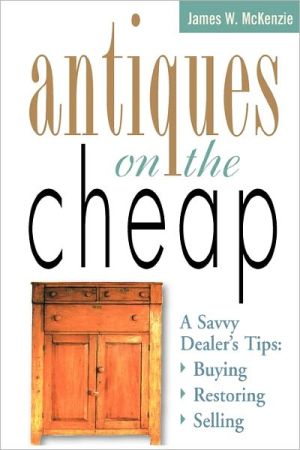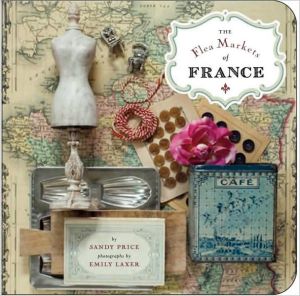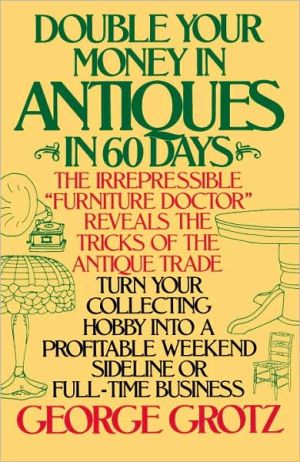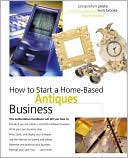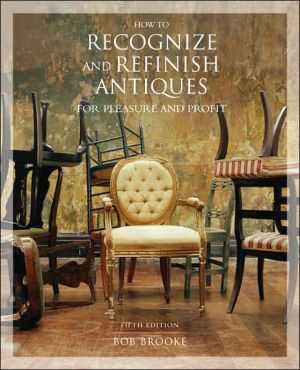Antiques on the Cheap: A Savvy Dealer's Tips: Buying, Restoring, Selling
Get the inside scoop on every aspect of antiquing - buying, cleaning, repairing, embellishing, refinishing, restoring, and selling. You'll find expert advice for getting great deals at auctions, flea markets, and shops, and you'll learn how to spot items that can be repaired to increase their value. Advice for selling antiques at flea markets, on consignment, and in shops is included.
Search in google:
Get the inside scoop on every aspect of antiquing and buying, cleaning, repairing, embellishing, refinishing, restoring, and selling. Expert advice for getting great deals at auctions, flea markets, and shops, and how to spot items that can be repaired to increase their value. Advice for selling antiques at flea markets, on consignment, and in shops is included.Author Biography: James W. McKenzie is presently a self-employed antique dealer and restorer who has 20 years of experience working in various antique businesses, putting much know-how advice into his book, Antiques on the Cheap. He has had 27 years of hands-on experience in restoration work and selling and currently restores American art pottery for other dealers. James has been married for 35 years to his wife, Wanda, and has two daughters and three grandchildren. He lives in West Virginia.Library JournalAlthough neither of these guides to antiques is particularly scholarly, McKenzie's is certainly more credible (albeit less fun to read) than Loomis's. McKenzie provides useful tips--not only for the business pro but also for the flea-market junkie--on how to rummage for, buy, and sell antiques and on how to establish a profitable business, with suggestions on such matters as calculating inventory turnover and handling tax records. He provides information on how to do minor repairs on collectibles and also offers guidance on major restoration projects, such as rebuilding old trunks or resilvering mirrors. The writing is straightforward, the advice is practical as well as easy to understand, and the book would be of interest to most antiques buffs. The title of the Loomis book pretty much sums up its content. While it does offer tips on "the hunt" and subsequent bargaining (and the etiquette of dealing with sellers), its primary focus is on the dating and identification of a wide variety of antiques (everything from World's Fair collectibles to Shaker furniture). While Loomis's breezy style may annoy some, readers familiar with his television appearances and videos will probably find this book enjoyable. Because his information is occasionally contradictory (he asserts, for example, that porcelain was first produced in Europe at the Meissen factory in Germany in 1709; two pages later he states that the French made porcelain in 1673), this book should not be considered an essential purchase unless there is patron demand.--Margarete Gross, Chicago P.L.
Introduction Part I: Buying 1 Taking the Mystery out of Auctions 2 Other Sources of Merchandise 3 What You Shouldn't Buy 4 What You Should Buy 5 Getting Good Things for Nothing Part II: Improving 6 Cleaning Wood Furniture 7 Marbleizing and Other Trick Finishes 8 If You Absolutely Must Strip 9 Refinishing 10 Trunk Restoration for the Amateur 11 Tricks for Cleaning Silver and Brass Part III: Fixing 12 Mending Chipped and Broken Pottery 13 No-Sew Lampshade Re-covering 14 Renovating and Converting Lamps 15 Resurrecting Frames and Mirrors 16 Furniture Repair for People with Few Tools Part IV: Selling 17 Where to Sell 18 How to Get and Keep Customers 19 Pricing Your Merchandise 20 Some Basics of Business Glossary Suggested Reading and References Sources: Suppliers and Manufacturers IndeX
\ Library JournalAlthough neither of these guides to antiques is particularly scholarly, McKenzie's is certainly more credible (albeit less fun to read) than Loomis's. McKenzie provides useful tips--not only for the business pro but also for the flea-market junkie--on how to rummage for, buy, and sell antiques and on how to establish a profitable business, with suggestions on such matters as calculating inventory turnover and handling tax records. He provides information on how to do minor repairs on collectibles and also offers guidance on major restoration projects, such as rebuilding old trunks or resilvering mirrors. The writing is straightforward, the advice is practical as well as easy to understand, and the book would be of interest to most antiques buffs. The title of the Loomis book pretty much sums up its content. While it does offer tips on "the hunt" and subsequent bargaining (and the etiquette of dealing with sellers), its primary focus is on the dating and identification of a wide variety of antiques (everything from World's Fair collectibles to Shaker furniture). While Loomis's breezy style may annoy some, readers familiar with his television appearances and videos will probably find this book enjoyable. Because his information is occasionally contradictory (he asserts, for example, that porcelain was first produced in Europe at the Meissen factory in Germany in 1709; two pages later he states that the French made porcelain in 1673), this book should not be considered an essential purchase unless there is patron demand.--Margarete Gross, Chicago P.L.\ \
